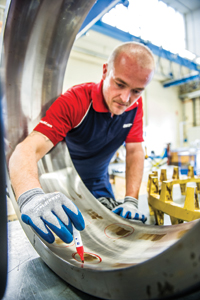
Posted to News on 23rd Oct 2019, 00:00
Improving plant performance with bearing remanufacturing
As companies look at ways to improve their environmental credentials and meet sustainability targets, remanufacturing is an attractive option for industrial bearings. Key components can be rebuilt in a way that cuts maintenance costs, improves reliability, and maximises plant performance. Paul Dysiewicz of SKF explains.

At the heart of every piece of rotating equipment, bearings large and small keep everything turning. Often considered as an afterthought, bearings are nonetheless a critical element of system reliability. Indeed, although only around 0.5% of bearings fail in use, with some 10 billion bearings manufactured annually this still represents some 50 million failed bearings every year.
In a large number of heavy industrial applications, a bearing failure can cripple production. Bearings represent a relatively small proportion of the total capital cost of equipment but given that the cost of a production line failure can be catastrophic, bearings are a significant business risk. Recognising this, many industries have regular maintenance and servicing regimes in place where key pieces of equipment are periodically inspected and serviced or replaced. Damage to bearings can be caused by factors such as poor installation, contaminants or poor lubrication, sporadic metal-to-metal contact in the rolling contact area, overloading or excess heating.
In production lines, hot mills, continuous casting lines or other industrial equipment, bearings are designed to withstand heavy duty load cycles and extreme conditions, and are typically sophisticated and over engineered. However, when excess wear is discovered, such bearings are often simply discarded and replaced with a new unit. While this solution does to some extent provide peace of mind, it is costly and wasteful. There are alternatives, such as remanufacturing, that yield better quality engineered solutions to increase reliability and performance and, consequently, production capacity.
With remanufacturing breathing new life into existing equipment, it is possible to lower maintenance costs and reduce the frequency of failures and stoppages whilst avoiding significant capital expenditure. Collectively, the result is enhanced reliability, improving production up-time and productivity, and giving a lower total cost of ownership.
Not only does remanufacturing offer a major contribution to reducing the life cycle costs of industrial equipment, there are also additional benefits. For example, remanufacturing offers an opportunity for root cause analysis of the wear or failure mode. Having performed careful analysis of the worn components, leading bearing suppliers are able to provide appropriate input to inform a plan of corrective action. This helps to avoid future problems and improves the operational reliability of the refurbished component in its specific application. Furthermore, bearings may be optimised for improved performance during the re-engineering process. In addition, the advent of new digital technologies has enabled far more sophisticated monitoring and maintenance programmes to be applied that are making a big contribution to industrial equipment reliability. More sophisticated sensors, providing information about the status of plant machinery through various monitoring channels, are being coupled with advanced analytical techniques.
Analysis can also include examination of the lubricant in order to detect metal wear particles which may indicate a specific area of damage for example. Gathering a far more detailed picture of the bearing condition, engineers are able to easily identify any damage or defects in the bearing at an early stage. This increases the time available to plan intervention and resolution of the issue in order to extend the life of the bearing or establish the optimum timing for maintenance or replacement activities, by exploiting more advanced predictive maintenance techniques.
Although typically operators considering bearing remanufacturing are looking at larger diameter bearings of 420mm and above, there are a multitude of diverse applications where bearing remanufacturing is an appropriate solution. The railway industry, machine tools, gearboxes, pulp and paper, and the marine sector are all suitable. Candidates for remanufacturing include backing bearings, slewing bearings, caster bearings such as spherical roller bearings and CARB bearings. Backing bearings are typically cylindrical roller bearings with extra wide outer rings and are found in cluster-type cold rolling mills as well as straightening or bending machines.
During the remanufacturing process an extensive analysis of bearing damage is carried out. Along with a visual inspection to determine the type and depth of damage, measurements of clearance, ovality and any wall-thickness variations along with other parameters are recorded. Additional non-destructive tests are also possible if required, such as phosphorescent crack detection and ultrasonic inspection.
All relevant functional surfaces are then remanufactured and if necessary, bearing components are replaced. Furthermore, remanufacturing can include modifications for different or higher specifications. This can also include mounting sensors, providing integrated lubrication or offering different sealing and coating solutions.
Depending on the condition of the bearing, remanufacturing might take from as little as a few hours to a number of days. Deep knowledge of both bearing manufacturing and the specific applications is crucial. This has a significant influence in determining the correct remanufacturing procedure to apply to ensure that the bearing is compatible with the application. Remanufacturing also offers the possibility of a maintained stock of replacement bearings that reduces lead times.
By remanufacturing, as much as 90% less energy is required when compared with producing a new component. And, taking into consideration the bearing size, complexity, condition and purchase price, substantial cost savings can be achieved by adopting a remanufacturing strategy.
A remanufacturing strategy for industrial bearings can offer substantial benefits to end users. By extending the service life and improving reliability, considerable operational cost reduction and energy savings are possible. With longer bearing service life and machine uptime, total life-cycle costs are reduced while at the same time, overall environmental impact is cut.
Above all, overall asset reliability is improved. Bearing remanufacturing, by industry leaders such as SKF, continues to be an important service for many demanding industrial sectors. Remanufacturing can support a company’s sustainability efforts, an area of growing importance and is a cost-effective way to significantly extend the life cycle of industrial bearings, gearboxes and drivelines.






